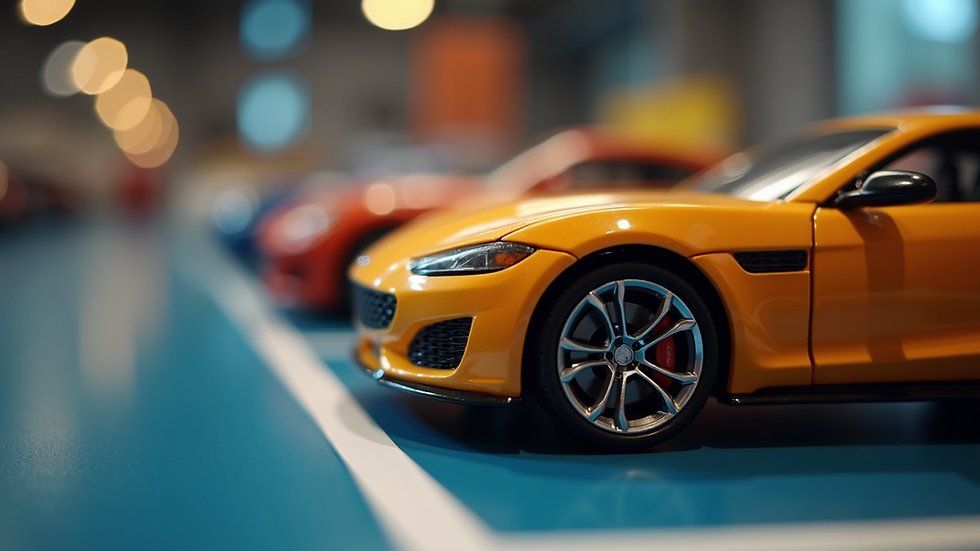Mastering the Art of Hobby Model Cars
- Deniz Uyanik

- 4 days ago
- 4 min read
Building and collecting hobby car models is a rewarding pastime that combines creativity, patience, and a passion for automobiles. Whether you are a beginner or an experienced modeler, mastering this art can bring immense satisfaction and a deeper appreciation for the intricate details of cars. This guide will walk you through essential tips, techniques, and insights to help you excel in the world of hobby car models.
Getting Started with Hobby Car Models
Starting your journey with hobby car models can be exciting but also overwhelming due to the variety of kits and tools available. The first step is to choose the right model kit that matches your skill level and interests. Beginners should look for kits labeled as "easy" or "beginner-friendly," which usually have fewer parts and simpler assembly instructions.
When selecting a model, consider the scale. Common scales include 1:24, 1:25, and 1:18. Smaller scales are easier to store and display, while larger scales allow for more detailed work. Also, decide whether you want to build a classic car, a modern vehicle, or even a racing car. This choice will influence the type of paint, decals, and accessories you might need.
Essential Tools and Materials
To build hobby car models effectively, you will need some basic tools:
Plastic cement or model glue: For assembling parts securely.
Hobby knife: To trim and clean parts.
Tweezers: For handling small pieces.
Sandpaper or sanding sticks: To smooth edges.
Paints and brushes: Acrylic or enamel paints work well.
Primer: Helps paint adhere better to plastic surfaces.
Decal setting solution: For applying decals smoothly.
Investing in quality tools will make your building process easier and improve the final result.

Techniques to Enhance Your Hobby Car Models
Once you have your kit and tools ready, mastering certain techniques will elevate your model-building skills. Here are some practical tips:
Preparation and Assembly
Before gluing, dry-fit the parts to ensure they fit perfectly. This step helps avoid mistakes and misalignments. Clean parts with warm soapy water to remove any mold release agents that could affect paint adhesion.
Use thin layers of glue to avoid excess that can mar the surface. Apply glue sparingly with a fine applicator or toothpick for precision.
Painting Tips
Painting is where your model truly comes to life. Start by applying a primer coat to create a smooth base. Use thin, even coats of paint to avoid drips and uneven surfaces. Allow each layer to dry completely before applying the next.
For realistic effects, try techniques like:
Dry brushing: Lightly brushing paint to highlight raised details.
Washes: Applying diluted paint to bring out panel lines and textures.
Masking: Using tape to create sharp paint edges or multi-color schemes.
Decals and Finishing Touches
Decals add authenticity to your model. Soak decals in water until they slide off the backing paper easily. Use decal setting solution to help them conform to curved surfaces and prevent silvering.
After decals dry, seal your model with a clear coat to protect the paint and decals. Choose between matte, satin, or gloss finishes depending on the look you want.

Displaying and Caring for Your Hobby Car Models
Once your model is complete, displaying it properly will preserve its beauty and showcase your hard work. Choose a dust-free environment with stable temperature and humidity to prevent damage.
Consider using display cases or shelves with glass covers to protect models from dust and accidental knocks. Position models away from direct sunlight to avoid paint fading.
Regularly dust your models with a soft brush or compressed air. Avoid using water or cleaning solutions that might damage paint or decals.
Exploring Advanced Customization Options
For those looking to take their hobby car models to the next level, customization offers endless possibilities. You can modify kits or create scratch-built parts to personalize your models.
Adding Lighting and Electronics
Installing LED lights in headlights, taillights, or dashboards adds realism. Small, battery-powered LED kits are available and can be integrated with some patience and basic wiring skills.
Weathering and Aging Effects
To simulate wear and tear, use weathering powders, pastels, or paint techniques to add rust, dirt, and grime. This approach is popular for military vehicles and vintage cars.
Custom Paint Jobs and Decals
Experiment with airbrushing for smooth gradients and complex patterns. You can also design and print custom decals to represent specific racing teams or personal logos.

Where to Find Quality Hobby Model Cars and Resources
Finding the right kits and learning materials is crucial for continuous improvement. Online stores and specialty shops offer a wide range of hobby car models, tools, and accessories.
One excellent resource is hobby model cars, which provides a curated selection of kits and supplies for enthusiasts of all levels. Their website also features tutorials and community forums where you can exchange tips and showcase your work.
Joining local or online model car clubs can also enhance your experience. These communities offer support, advice, and opportunities to participate in contests and exhibitions.
Embracing the Journey of Model Car Building
Mastering hobby car models is a journey filled with learning and creativity. Each project improves your skills and deepens your appreciation for automotive design. Remember to be patient, enjoy the process, and celebrate your progress.
With dedication and the right techniques, you can create stunning models that reflect your passion and craftsmanship. Whether displayed proudly on a shelf or shared with fellow enthusiasts, your hobby car models will be a testament to your artistic journey.


